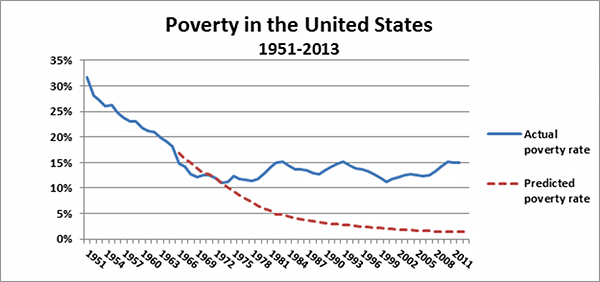
This is a fascinating chart. From the end of World War II until 1964, poverty in this country was cut in half. The dotted line shows where poverty would have gone if the trend had continuted -- economic growth would have reduced poverty to a mere 1.4 percent of the population. Of course the trend did not continue. Starting in 1965, the poverty rate flattened out, so the poverty rate is at 15 percent, just 3 percent below where it was in 1965. And that year, of course, was when the War on Poverty was launched.
That’s after spending $15 trillion on antipoverty programs and continuing to spend $1 trillion a year.
[. . .]
So here is the important public policy question: If it is well established that self-sufficiency is closely related to working and being married why are we “fighting poverty” by doing things that social scientists have known for decades lead to less work and fewer marriages?
And here is a public discourse question: why are New York Times columnists Paul Krugman and Nicholas Kristof declaring the War on Poverty a success when it is so obviously a failure? Both columnists claim that if we count goods-in-kind (Food Stamps, housing, Medicaid, etc.), the actual poverty rate would be lower by one-third. Of course, if we give people enough stuff and count it as income, we could declare victory and claim that there is no more poverty.
Of course, the way government sees it, if something isn't working the answer is to do more of it.



